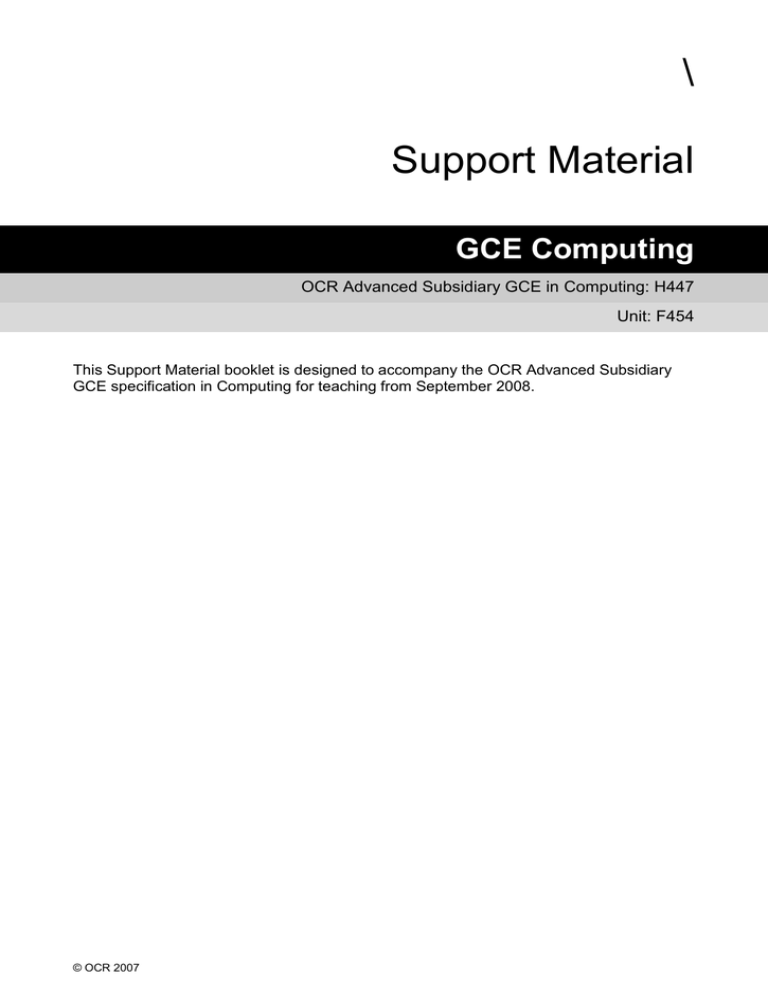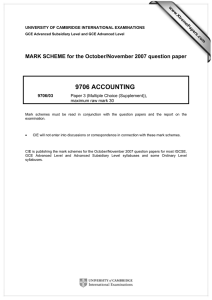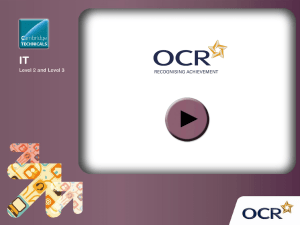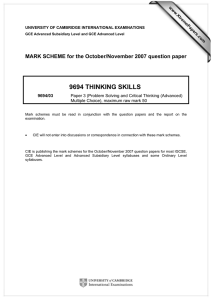Unit F454 - Booklet - Scheme of work and lesson plan booklet (DOC, 293KB)
advertisement

\ Support Material GCE Computing OCR Advanced Subsidiary GCE in Computing: H447 Unit: F454 This Support Material booklet is designed to accompany the OCR Advanced Subsidiary GCE specification in Computing for teaching from September 2008. © OCR 2007 Contents Contents 2 Introduction 3 Scheme of Work 5 Lesson Plan 12 Other forms of Support 16 2 of 19 GCE Computing Introduction Background A new structure of assessment for A Level has been introduced, for first teaching from September 2008. Some of the changes include: The introduction of stretch and challenge (including the new A* grade at A2) – to ensure that every young person has the opportunity to reach their full potential The reduction or removal of coursework components for many qualifications – to lessen the volume of marking for teachers A reduction in the number of units for many qualifications – to lessen the amount of assessment for learners Amendments to the content of specifications – to ensure that content is up-to-date and relevant. OCR has produced an overview document, which summarises the changes to Computing. This can be found at www.ocr.org.uk, along with the new specification. In order to help you plan effectively for the implementation of the new specification we have produced this Scheme of Work and Sample Lesson Plans for Computing. These Support Materials are designed for guidance only and play a secondary role to the Specification. Our Ethos All our Support Materials were produced ‘by teachers for teachers’ in order to capture real life current teaching practices and they are based around OCR’s revised specifications. The aim is for the support materials to inspire teachers and facilitate different ideas and teaching practices. Each Scheme of Work and set of sample Lesson Plans is provided in: PDF format – for immediate use Word format – so that you can use it as a foundation to build upon and amend the content to suit your teaching style and students’ needs. The Scheme of Work and sample Lesson plans provide examples of how to teach this unit and the teaching hours are suggestions only. Some or all of it may be applicable to your teaching. GCE Computing 3 of 19 The Specification is the document on which assessment is based and specifies what content and skills need to be covered in delivering the course. At all times, therefore, this Support Material booklet should be read in conjunction with the Specification. If clarification on a particular point is sought then that clarification should be found in the Specification itself. A Guided Tour through the Scheme of Work = Innovative Teaching Idea All the teaching idea contained in the SOW are innovative, but the icon is used to Highlight exceptionally innovative ideas. = Stretch & Challenge Activity This icon is added at the end of text when there is an explicit opportunity to offer Stretch and Challenge. = ICT Opportunity This icon is used to illustrate when an activity could be taught using ICT facilities. 4 of 19 GCE Computing GCE Computing H047/H447: Unit F454 Section title: 3.4.1 Definition, investigation and analysis Specification content Teacher guidance Section summary Candidates should be able to: Clarification and suggestions Define a task a. define the nature of the task to be carried out; Research the task and needs of the enduser(s) A candidate should not expect the examiner to be familiar with the theory and practice in the area of the chosen system. b. identify methods by which to investigate the problem, including questionnaires, observation and structured interviews; Record findings Analyse findings Project plan including specification of the requirements: – user – hardware – software The candidate must plan the investigation carefully with initial questions and subsidiary questions. It is unlikely that the detailed requirements will be gathered through a single session and the candidate should plan to refine the detail gathered at each stage in order to focus more accurately on what is required by the end user in the final solution. Existing documents, systems, data or methods should be collected / observed and recorded. Suggested teaching time range 8 hours c. record information/data and gather sample documents currently used; d. identify the current processes and current data; e. analyse the data and processes: candidates will be expected to use appropriate techniques such as structure diagrams/data flow diagrams/system flowcharts to illustrate their analysis; = Innovative teaching idea 5 of 19 Teacher notes The information and data collected in the investigation stages must be analysed carefully and presented to the end user to illustrate the findings and indicate the way forward. = Stretch and challenge opportunity idea = ICT opportunity GCE Computing GCE Computing H047/H447: Unit F454 Section title: 3.4.1 Definition, investigation and analysis Suggested teaching time range 8 hours Section summary Specification content Teacher guidance Candidates should be able to: Clarification and suggestions f. The candidate must plan the investigation carefully and analyse their findings. These findings should be reported back to the end user for consideration. There should be a cyclic approach to this section focussing more accurately at each stage on what is to be achieved. specify any perceived problems and inefficiencies apparent from discussions with the user and the analysis work carried out; g. derive the user and information requirements of a system; h. specify and justify the required hardware; i. 6 of 19 specify and justify the required software The final specification for the system should be presented to the end user as the basis for a contract between them and the candidate. GCE Computing Teacher notes GCE Computing H047/H447: Unit F454 Section title: 3.4.2 Design Suggested teaching time range Specification content 10 hours Teacher guidance Section summary Candidates should be able to: Clarification and suggestions Detailed system design including: a. specify the objectives of the proposed system and relate them to the requirements specification; The objectives follow from the requirements specification and it should be possible to demonstrate through testing that these have been achieved b. design and document data capture forms and/or screen layouts, drawing up detailed mock-ups of the proposed interface; Outline designs for the user interface are important. These can be prototyped using suitable software or hand drawn as appropriate. c. design and document report layouts, screen displays and/or other forms of output (for example, audio output), drawing up detailed mock-ups of the proposed interface; d. identify, develop and document a test strategy for the design; e. select suitable test data for the design; f. design and document using appropriate techniques (for example, data flow diagrams) the data structures necessary to solve the inefficiencies/problems indicated in the requirements specification; data structures input-output format processes involved A clear test strategy including test data needs to be developed to ensure the system meets the design objectives. A clear design specification: Specify the objectives relating them to the requirements specification g. design and document an algorithm/pseudocode/top-down diagram or other form of process model; Input design h. Output design using appropriate techniques test that the algorithms meet the design objectives. Design and test plan GCE Computing The objectives must be tested to demonstrate that they have been achieved. As a system is developed the various stages in its development are tested to ensure they work before moving on. A test strategy is vital to ensure this process anticipates how this ongoing testing will proceed. For future maintenance and to demonstrate the processes it is vital that the process is adequately documented. Good code design requires careful planning and the candidate must use the available techniques to demonstrate this planning and development of their system This section refers to testing the algorithms, not the code and candidates should demonstrate that their algorithms achieve the desired results using suitable techniques. 7 of 19 Teacher notes GCE Computing H047/H447: Unit F454 Section title: 3.4.2 Design Suggested teaching time range 10 hours Section summary and test data Data structures/variable Algorithms Test algorithms 8 of 19 Specification content Candidates should be able to: Teacher guidance Clarification and suggestions GCE Computing Teacher notes GCE Computing H047/H447: Unit F454 Section title: 3.4.3 Software development and testing Suggested teaching time range 18 hours Specification content Teacher guidance Section summary Candidates should be able to: Clarification and suggestions Develop a software solution and, using the test plan developed in Topic 2: Design, show that the system works with valid, invalid and borderline data (or, if it does not, under which circumstances it fails) a. develop the rules/methods/algorithms of a design using a programming language; This is the development stage of the process. The project requires that the solution be substantially coded in a suitable high level language. The techniques expected are those introduced in previous modules. The code developed should be based upon the earlier design stages and the candidate should demonstrate clearly how the coding relates to the design. Annotation is essential for future maintenance of the system. As a guide line full annotation implies that were the code removed and only the annotation left, then the programme could be re coded and achieve the same result. Candidates should also use meaningful variable names. The system must be tested during development to show the intermediate stages working. The final system must be tested by the developer for function and to ensure it meets the design objectives. There should also be evidence of end user testing. All of the testing must be carefully planned to demonstrate how the system meets the design objectives and all output from testing must be cross referenced against this plan. Test plan clearly crossreferenced to evidence that the system has been tested during development and implementation Evidence of user testing Software development Alpha testing GCE Computing b. develop the data structures of the design using the appropriate features of a programming language; c. develop inputs/outputs using the features of a programming language; d. produce suitable modular code with full annotation and a description of how the modules combine to create the solution; e. test and refine the software solution during development, illustrating how the software solution evolves; f. test the software solution with the user, providing documented evidence that the solution works; g. produce detailed output from the testing, cross referencing as appropriate with the test plan. 9 of 19 Teacher notes GCE Computing H047/H447: Unit F454 Section title: 3.4.3 Software development and testing Suggested teaching time range 18 hours Section summary Response to the results of testingBeta testing Response to the results of beta testing Modularisation of code Code documentation Use of modules, data structures and objects In-code documentation Code structure Applying the test plan and data 10 of 19 Specification content Candidates should be able to: Teacher guidance Clarification and suggestions GCE Computing Teacher notes GCE Computing H047/H447: Unit F454 Section title: 3.4.4 Documentation Suggested teaching time range Specification content 6 hours Teacher guidance Section summary Candidates should be able to: Clarification and suggestions a. The system should be self documenting with suitable on screen instructions and help There will be some necessary paper based documentation to ensure the system can be implemented successfully and this should be included The software solution should be self documenting with suitable on-screen help and support for the end user(s) develop detailed and appropriate user documentation. Teacher notes All necessary supporting documentation required to enable the end user to make effective use of the solution. = Innovative teaching idea GCE Computing = Stretch and challenge opportunity idea = ICT opportunity 11 of 19 Lesson Plan: GCE Computing H047/H447 Unit F454 Section title: 3.4.1e Analyse Findings Introduction OCR recognises that the teaching of this qualification will vary greatly from school to school and from teacher to teacher. With that in mind, this lesson plan is offered as a possible approach but will be subject to modifications by the individual teacher. Lesson length is assumed to be one hour. Learning objectives for the lesson Objective 1 Students will understand the need to analyse the results of an interview and the need for planned further investigation Objective 2 Students will identify what further data they will need to collect in the investigation stage Objective 3 Students will appreciate the various investigation strategies they can employ Recap of previous experience and prior knowledge The students have formulated an initial set of questions and possibly completed their first interview with their end user. Content Time Content 5 minutes Recap on the scenario introduced and the information gathered during the questioning process. 10 minutes Whole class discussion about what extra information needs to be collected from the end user and how this might be obtained Further questions Questionnaires Observation Collecting documents others 10 minutes In suitable groupings the students need to identify what they have already discovered and what else they need to find out. They should formulate extra questions to ask in the role play. 10 minutes Students ask their questions in a role play situation with the teacher in order 12 of 18 GCE Computing Time Content to identify more detailed requirements for this project. 15-20 The students should analyse their findings and formulate an outline specification for the task discussed with the teacher. Consolidation Time Content 10 minutes Discuss the analysis and consider how this applies to their identified projects and what other techniques might bee appropriate to each of the students. Homework Topic Teacher notes Planning for the interview If students have completed their initial interview with the end user they need to analyse the findings and develop a plan for further investigation of the problem. GCE Computing 13 of 19 Lesson Plan: GCE Computing H047/H447 Unit F454 Section title: 3.4.2a Specify system objectives Introduction OCR recognises that the teaching of this qualification will vary greatly from school to school and from teacher to teacher. With that in mind, this lesson plan is offered as a possible approach but will be subject to modifications by the individual teacher. Lesson length is assumed to be one hour. Learning objectives for the lesson Objective 1 Students will understand how to specify measurable objectives based on a requirements specification Objective 2 Students will be able to produce a set of objectives for a problem Objective 3 Students will be able to use suitable diagrams to specify a solution Recap of previous experience and prior knowledge The previous sessions have used role play to investigate a sample scenario and students, through Q&A sessions have identified the end user requirements for this project. Students should also have made significant progress with investigating their own projects Content Time Content 10 minutes Recap on the requirements specification developed during the role play sessions. 10 -15minutes Whole class discussion about how the requirements specification can be re worked into a testable set of objectives. Discussion about how diagrams can be used effectively to represent the structure of the proposed solution. 15 -20minutes In suitable groups the students should formulate a suitable set of testable objectives for the sample task and suitable diagrams can be utilised to clarify the structure of the proposed solution. 10 minutes Students present their results to the class for discussion. 14 of 18 GCE Computing Consolidation Time Content 10 minutes Recap the key elements from the session and discuss briefly how these might apply to the individual projects. Homework Topic Teacher notes Students should start to develop suitable objectives and initial diagrammatic representations of the proposed solutions to their own projects. The teacher should consider what they would require from the chosen project in advance in order to play the role of the end user in this activity. GCE Computing 15 of 19 Other forms of Support In order to help you implement the new Computing specification effectively, OCR offers a comprehensive package of support. This includes: OCR Training Get Ready…introducing the new specifications A series of FREE half-day training events are being run during Autumn 2007, to give you an overview of the new specifications. Get Started…towards successful delivery of the new specifications These full-day events will run from Spring 2008 and will look at the new specifications in more depth, with emphasis on first delivery. Visit www.ocr.org.uk for more details. Mill Wharf Training Additional events are also available through our partner, Mill Wharf Training. It offers a range of courses on innovative teaching practice and whole-school issues - www.mill-wharf-training.co.uk. e-Communities Over 70 e-Communities offer you a fast, dynamic communication channel to make contact with other subject specialists. Our online mailing list covers a wide range of subjects and enables you to share knowledge and views via email. Visit https://community.ocr.org.uk, choose your community and join the discussion! 16 of 18 GCE Computing Interchange OCR Interchange has been developed to help you to carry out day to day administration functions online, quickly and easily. The site allows you to register and enter candidates online. In addition, you can gain immediate a free access to candidate information at you convenience. Sign up at https://interchange.ocr.org.uk Published Resources OCR offers centres a wealth of quality published support with a fantastic choice of ‘Official Publisher Partner’ and ‘Approved Publication’ resources, all endorsed by OCR for use with OCR specifications. Publisher partners OCR works in close collaboration with three Publisher Partners; Hodder, Heinemann and Oxford University Press (OUP) to ensure centres have access to: Better published support, available when you need it, tailored to OCR specifications Quality resources produced in consultation with OCR subject teams, which are linked to OCR’s teacher support materials More resources for specifications with lower candidate entries Materials that are subject to a thorough quality assurance process to achieve endorsement Hodder Education is the publisher partner for OCR GCE Computing Hodder Education is producing the following resources for OCR GCE Computing for first teaching in September 2008, which will be available in Spring 2008._ OCR Computing for A level by Chris Leadbetter, Agneau, George Rouse OCR Computing for A level Dynamic Learning Network Edition CD ROM by Chris Leadbetter, Agneau, George Rouse GCE Computing 17 of 19 Approved publications OCR still endorses other publisher materials, which undergo a thorough quality assurance process to achieve endorsement. By offering a choice of endorsed materials, centres can be assured of quality support for all OCR qualifications. Endorsement OCR endorses a range of publisher materials to provide quality support for centres delivering its qualifications. You can be confident that materials branded with OCR’s “Official Publishing Partner” or “Approved publication” logos have undergone a thorough quality assurance process to achieve endorsement. All responsibility for the content of the publisher’s materials rests with the publisher. These endorsements do not mean that the materials are the only suitable resources available or necessary to achieve an OCR qualification. Any resource lists which are produced by OCR shall include a range of appropriate texts. 18 of 18 GCE Computing




